Rustic Living Room Ideas: Comfort Meets Style
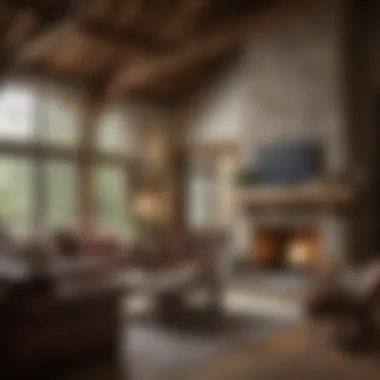
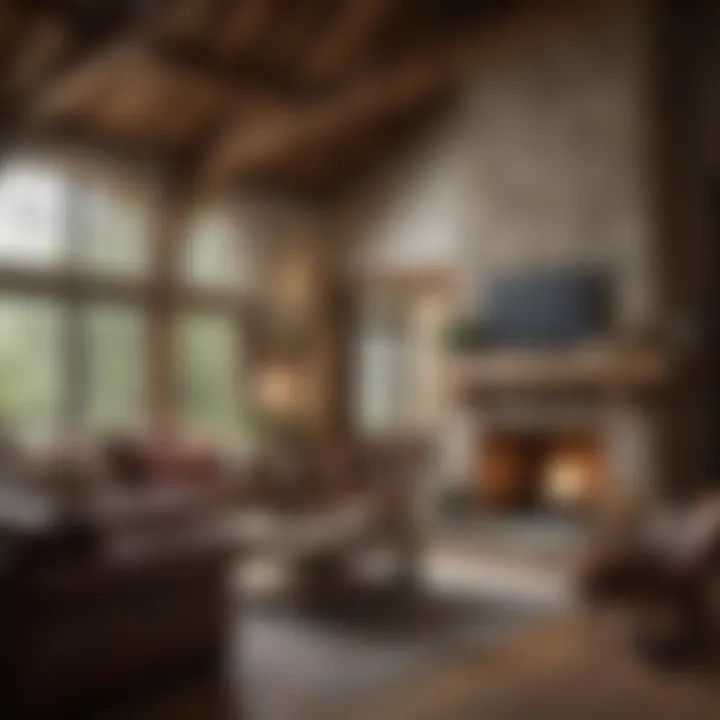
Intro
Creating a rustic living room is a journey into a world where comfort meets style. This design aesthetic draws inspiration from nature, often incorporating elements like wood, stone, and organic fabrics. A rustic living room does not merely serve as a gathering space; it reflects an appreciation for craftsmanship and a desire to bring the outdoors inside. As we explore these ideas, it is crucial to understand the fundamentals that create this ambiance. This guide will unfold insights into materials, color selection, and furniture choices, while also providing practical advice for implementation in your living space.
Key Insights and Trends
The rustic living room trend has evolved, adapting to contemporary sensibilities while retaining its core principles. Current trends emphasize sustainability and the use of reclaimed materials. This means that furniture and decor are not just about aesthetics; they tell a story of responsible sourcing and environmental consciousness.
Current Trends in Interior Design
- Natural Materials: More homeowners prefer natural wood and stone. These elements bring warmth and texture to living spaces, essential for achieving a rustic feel.
- Neutral Color Palette: Shades of beige, soft greens, and browns work harmoniously in rustic design. These colors reflect the hues found in nature, enhancing the serene ambiance.
- Eclectic Decor: Mixing modern pieces with vintage finds can provide an intriguing aesthetic balance that celebrates both old and new.
Popular Gardening Techniques of the Season
Although gardening may seem distant from the living room aesthetic, it can greatly enhance the rustic theme. Consider incorporating plants that thrive indoors, such as:
- Willow
- Ferns
- Herbs like basil and thyme for both beauty and utility.
This seasonal blending of indoor flora complements the rustic style, as it brings life and freshness into the space. Plants not only enhance the overall aesthetic but also improve air quality, making a home more inviting.
Practical Tips and How-To Guides
Venturing into the realm of rustic living room design requires some guided steps. Here, we provide the framework to help you transform your space effectively.
Step-by-Step Guide for Home Decoration Projects
- Choose Your Base Material: Start with choosing wooden flooring or reclaimed wood accents. This can set the tone for the entire room.
- Select a Color Palette: Opt for natural tones. Test the paint on your wall to see how it interacts with lighting throughout the day.
- Pick Appropriate Furniture: Look for sturdy, comfortable pieces. A large sectional made from natural materials can serve as a focal point.
- Incorporate Textiles: Use cotton or linen throws, and woolen rugs to add layers of warmth and comfort.
- Add Decorative Elements: Consider artwork depicting landscape scenes or vintage items from local flea markets to enhance the rustic charm.
Entertaining Tips and Planning Checklists
- Create Zones: Designate areas for seating, reading, or socializing. This organization will make gatherings more enjoyable.
- Mood Lighting: Use soft lighting, such as table lamps with warm bulbs, to create an inviting atmosphere.
- Checklist for Hosting: Prepare a list for essentials like seating arrangements, refreshments, and choosing ambient music to complement the rustic feel.
Properly executed rustic designs can transform a standard room into a vibrant yet cozy space, making it suitable for both relaxation and entertaining.
Understanding these elements can help you create a living room that is not only stylish but also a true reflection of your personality and values. The balance between comfort and elegance is achievable when thoughtful choices shape your design strategy.
Understanding Rustic Aesthetics
Rustic aesthetics have become more than just a fleeting trend in interior design. They present a way of life, prioritizing simplicity and authenticity. Understanding rustic aesthetics is crucial for anyone looking to create a warm and inviting living room that reflects natural beauty and comfort. This section delves deep into the essence of rustic style, examining its definition, historical background, and the key characteristics that make it unique.
Defining Rustic Style
Rustic style is fundamentally rooted in a love for nature and the organic materials that make it up. It typically emphasizes natural textures, muted tones, and handcrafted elements. In a rustic living room, you might find reclaimed wood beams, stone fire places, and textiles made from natural fibers. The aim here is to create a harmonious environment that feels both homey and connected to the earth.
This style often resonates with those who appreciate craftsmanship over mass production. It invites a sense of nostalgia and simplicity, steering away from modern complexity. Therefore, when defining rustic style, consider the balance between form and function, ensuring that each piece contributes to an overall atmosphere of peace and authenticity.
Historical Context
The historical context of rustic design is vital in comprehending its contemporary application. Historically, rustic living spaces originated from rural lifestyles. They were practical and primarily focused on utility rather than aesthetic appeal. Craftsmen would use local materials available to them, leading to a unique and regional approach to construction and decor.
As urbanization took hold, people began to look back at simpler times. The movement toward rustic styles gained momentum in the late 20th century, especially as more homeowners sought to create cozy retreats that felt removed from the busy urban life. The rustic approach embraced a return to basics, emphasizing sustainability and traditional craftsmanship. This gives rustic design its most distinguishing feature: a meaningful connection to the past.
Key Characteristics
Understanding the key characteristics of rustic living rooms can aid homeowners and designers alike in crafting spaces that embody this aesthetic. Here are some main points to consider:
- Natural Materials: The core of rustic design centers around wood, stone, and metal. These materials should be displayed in their natural forms, enhancing the authenticity of the space.
- Neutral and Earthy Colors: The color palette typically includes soft browns, greens, and grays, echoing the colors found in nature. These tones create a calming backdrop.
- Handcrafted Elements: Unique, handmade furniture and decor items contribute to the atmosphere, making each piece a point of interest and a conversation starter.
- Warm Lighting: Fixtures that mimic natural light, such as wrought iron lamps or lanterns, help create an inviting environment.
- Layered Textures: Combining various textures through fabrics, such as wool or burlap, adds depth to the room and promotes a sense of coziness.
"Rustic living rooms are not merely defined by their decor, but by a deeper philosophy that celebrates lifestyle choices rooted in simplicity and nature."
In summary, understanding rustic aesthetics involves recognizing its deep-rooted connections to nature and history. Homeowners can create inviting spaces by grasping the core elements, making thoughtful choices that embrace the warmth and character of rustic design.
Essential Elements of Rustic Design
Creating a rustic living room hinges on several essential elements that underscore its unique character. These elements are not merely aesthetic choices; they represent a commitment to a style that embraces simplicity and authenticity. Incorporating natural materials, a thoughtful color palette, and appropriate furniture can transform a space into a cozy haven. Each element plays a significant role in cultivating an inviting atmosphere that resonates with the essence of rustic design. What is crucial is the harmony and balance in utilizing these elements to avoid overwhelming the space while still achieving that desired charm.
Natural Materials
Wood
Wood is the backbone of rustic design, lending warmth and character to any living room. It's a versatile material that comes in various forms, from reclaimed beams to raw planks. The distinct grains and knots of wood make each piece unique, enhancing the overall aesthetic. Its organic nature makes it a top choice, as it naturally complements other materials in the rustic framework. The notable strength of wood can be both an advantage and disadvantage; while it provides longevity, it may require regular maintenance to preserve its luster. Additionally, the use of sustainable wood sources aligns with eco-friendly practices in interior design.
Stone
Stone adds a solid, grounding feel to rustic spaces. Commonly used for fireplaces, accent walls, and flooring, its natural ruggedness evokes a sense of the outdoors. Stone comes with various textures and finishes, offering opportunities to create visual interest. This material is praised for its durability and timeless appeal. However, incorporating stone can raise installation costs, and its weight may limit some design options. Nonetheless, when used effectively, stone can serve as a stunning focal point that enriches the rustic simplicity.
Metal
Metal elements, often found in furniture accents or light fixtures, introduce a contrasting texture that can enhance the rustic vibe. Materials like wrought iron or aged metal can provide a vintage feel. Metal is also known for its resilience, which can be a huge advantage in high-traffic areas within the living room. The industrial aspect of metal can sometimes diverge from the pure rustic aesthetic, so it’s essential to strike the right balance. Integrating metal thoughtfully ensures that it supports the rustic theme rather than detracting from it.

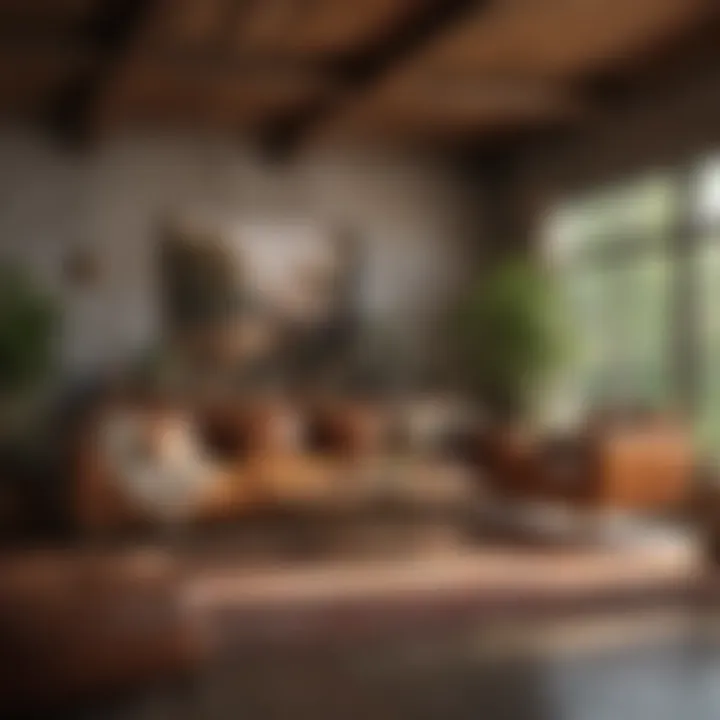
Color Palettes
Neutral Tones
Neutral tones form the foundation of a rustic color scheme. Whitespace in combination with creams, browns, and gray promotes a sense of calm, linking well with natural elements. These colors reflect the simplicity and understated elegance of rustic design. The muted shades create a canvas that allows other elements to shine, preventing the room from feeling cluttered. However, overreliance on neutral tones can lead to a lifeless atmosphere; incorporating varying shades and textures is crucial to avoid monotony.
Earthy Colors
Earthy colors, such as terracotta, olive green, and deep browns, embody the very essence of nature. These shades breathe life into a rustic living room, adding depth and warmth. They resonate with the outdoors, cultivating a harmonious ambiance. Earthy tones also provide a cozy feel, encouraging relaxation. While these colors are beneficial for enhancing rustic interiors, they can potentially overpower a small space if not balanced correctly with lighter elements.
Accent Shades
Accent shades serve as the perfect tool to highlight features within a rustic living room. Bold colors like rust red or deep navy can add vibrancy without compromising the muted theme. These colors draw attention to specific areas, such as decorative pillows or artwork. When applied thoughtfully, they can inject personality into the design. However, caution is necessary, as overly bright colors can detract from the fundamental rustic feel.
In summary, the essential elements of rustic design, such as natural materials and deliberate color choices, are crucial for creating a warm and inviting living room. Incorporating wood, stone, metal, and carefully selected colors will help achieve a harmonious environment that embodies the rustic aesthetic.
Furniture Choices for a Rustic Living Room
Furniture selection is a crucial aspect of creating a rustic living room. The right pieces can accentuate the natural and cozy feel desired in such spaces. Furniture choices should seamlessly blend comfort with rustic charm while offering practicality. Each item contributes to the overall aesthetic and function of the room, making thoughtful selection imperative for achieving a harmonious rustic style.
Sofa and Seating Arrangements
Chesterfield Sofas
Chesterfield sofas are known for their distinctive design, characterized by deep button tufting and rolled arms. Their elegant yet comfortable appearance makes them a significant addition to a rustic living room. The plush architecture of Chesterfield sofas serves a dual purpose: providing comfort while also adding a touch of sophistication.
A key characteristic of these sofas is their timeless appeal, as they can complement both traditional and modern rustic interior styles. A rich leather finish can enhance the rustic vibes, while fabrics like linen or cotton make for a more relaxed look. However, the weight and bulkiness can present challenges during rearrangement.
Reclaimed Wood Chairs
Reclaimed wood chairs embody sustainability. Using salvaged wood speaks to an eco-friendly approach, fitting beautifully within rustic aesthetics. Their primary features are unique finishes and textures, which tell a story of their past life.
Such chairs are popular in rustic settings because of their organic appeal and durability. They often carry imperfections, which contribute to their charm. One consideration here is that they may not always be uniform, which can lead to inconsistencies in overall decor. However, those differences can enhance personalization.
Slipcovered Furniture
Slipcovered furniture offers a practical solution without sacrificing style. Its versatility allows for easy cleaning and can adapt to changing seasons or styles. The characteristic of slipcovers is their removable nature, providing a straightforward way to refresh the look of your furniture.
Choosing slipcovered items can bring a relaxed and approachable vibe to a rustic living room. They also come in various materials, such as cotton or linen, which are breathable and easy to maintain. A possible downside is that the covers can shift or wear over time, requiring periodic adjustments or replacements.
Tables and Storage Solutions
Coffee Tables
Coffee tables serve as a central focus in living areas, promoting both function and style. In rustic living rooms, wooden coffee tables made from reclaimed or distressed wood are often favored. Their warmth adds a welcoming element, inviting gatherings and conversations.
A defining feature is their sturdiness, making them reliable surfaces for everyday use. Many rustic coffee tables also boast unique designs or added storage through shelves or drawers. However, some may find certain styles too heavy or bulky, which could overwhelm a smaller space.
Console Tables
Console tables hold practicality in high regard, often placed against walls or in entryways. In rustic design, they can be crafted from natural materials to create a seamless flow with other elements in the space. A notable characteristic is their slim profile, which provides additional surfaces without encroaching too much on floor space.
Selecting a console table that fits the rustic style can bring character to a room. Some may include decorative features like wrought iron handles or artistic legs. The downside is that their purpose can sometimes be limited in comparison to bulkier furniture, which may dilute their effectiveness in storage or display.
Bookshelves
Bookshelves provide not just storage, but also a means of displaying personal collections and contributing to room decor. In rustic living rooms, these shelves often utilize raw wood, enhancing the natural look. A standout feature is their ability to be custom-designed, allowing for tailored fits in various spaces.
They can serve as functional art pieces, showcasing books and decor items alike. On the other hand, depending on the construction, some bookshelves may require regular maintaining to prevent wear and tear, especially if made from older woods.
In summary, selecting the right furniture is essential in establishing a rustic living room. It should prioritize comfort, sustainability, and style, creating an inviting atmosphere.
Decorative Elements to Enhance Rustic Space
Decorative elements play a crucial role in establishing the ambiance of a rustic living room. They provide the finishing touches that tie together various design aspects, ensuring the space feels cohesive and inviting. When selecting decorative elements, it is essential to consider their compatibility with the overall rustic style. The right decorations can enhance textures, colors, and materials used in the space, enriching the overall experience and creating a warm, welcoming atmosphere.
Wall Decor
Artwork
Artwork serves as a focal point in any living room. In rustic spaces, it typically features natural themes, landscapes, or wildlife. This kind of artwork reflects the authenticity of the rustic style by bringing the beauty of nature indoors.
Key characteristic: The versatility of artwork allows for various interpretations of rustic living. Framed prints or paintings made from reclaimed materials can add both character and texture to the walls.
Unique feature: Artwork composed of earthy colors and textures enhances the space's warmth, providing comfort. An advantage is its ability to evoke emotions while also being a conversation starter. However, too much or mismatched artwork may lead to a chaotic look.
Mirrors
Mirrors play an important role in rustic design, serving both aesthetic and functional purposes. They can open up smaller spaces, making them feel larger and more inviting. Rustic mirrors often feature distressed frames made from wood or metal.
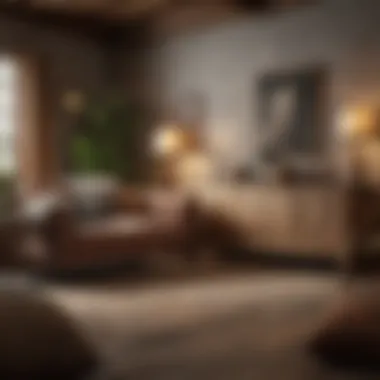
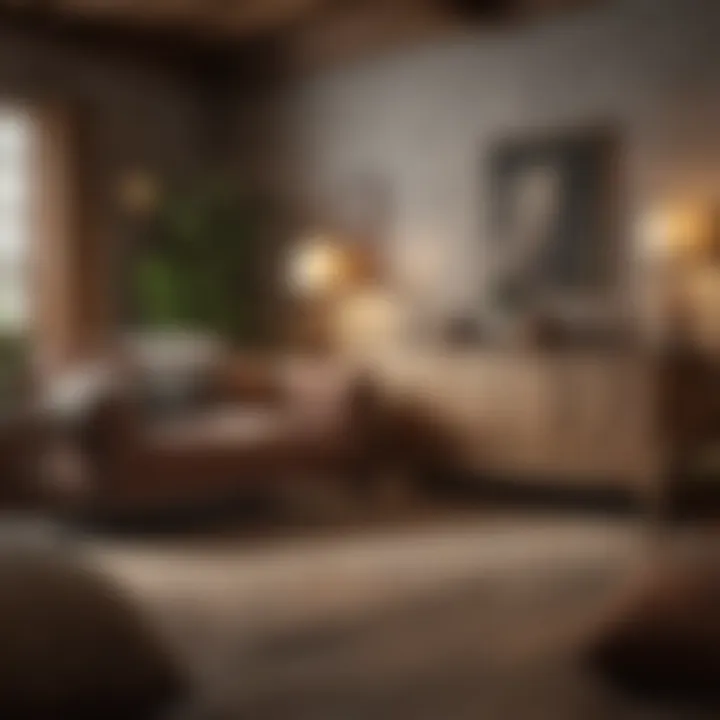
Key characteristic: The reflective surface of mirrors can enhance natural light, creating a bright and airy feeling in a rustic room.
Unique feature: Incorporating mirrors with a weathered or antique finish can harmonize well with the rustic theme. One advantage is that they can add depth, but an overly polished mirror may disrupt the rustic feel.
Wall Sconces
Wall sconces are lighting fixtures that can significantly contribute to the rustic aesthetic. When selected thoughtfully, they provide warm illumination and enhance the overall atmosphere of the room. Rustic wall sconces often feature materials like wrought iron, wood, or glass.
Key characteristic: Wall sconces add a layering effect to lighting design, creating a cozy, intimate environment.
Unique feature: Many rustic wall sconces have an artisanal touch, supporting handcrafted aesthetics. They provide advantages including space-saving and accentuating specific areas. However, improper placement can lead to uneven lighting and diminish their effectiveness.
Textiles and Soft Furnishings
Rugs
Rugs help define spaces within a room while also adding warmth. In rustic living rooms, they typically feature natural fibers like jute, wool, or cotton. Opting for earthy tones and patterns enhances the rustic aesthetic.
Key characteristic: A well-chosen rug can anchor furniture, providing a sense of stability while incorporating texture.
Unique feature: Rugs help to absorb sound, making the room more inviting. However, maintenance can be a factor, especially if they are light-colored or require specialized cleaning.
Cushions
Cushions serve a dual function: they provide comfort and style. Mixing different textures and patterns can create an inviting space, while maintaining the rustic theme.
Key characteristic: Cushions made from natural fabrics enhance the tactile experience in the room.
Unique feature: They are easy to swap out or rearrange, allowing for seasonal updates. The downside may be that too many cushions can clutter the space, overwhelming the rustic simplicity.
Throws
Throws add an element of coziness to rustic living rooms. They can be draped over sofas or used for warmth on chilly evenings. Typically crafted from wool or soft cotton, throws promote warmth and comfort.
Key characteristic: The texture of throws can contribute significantly to the sensory experience of the space.
Unique feature: Versatile in function, they can be decorative and practical. A disadvantage is that displays may look unkempt if not arranged properly.
Lighting Considerations in Rustic Rooms
In a rustic living room, lighting plays a vital role in shaping the atmosphere. Good lighting can enhance the natural materials and textures that embody rustic design. It is critical for both function and ambiance. Different types of lighting achieve various effects, contributing to overall comfort and style.
Types of Lighting
Ambient Lighting
Ambient lighting provides the overall illumination for a space. It creates a soft light that fills the room and sets the mood without overwhelming brightness. This lighting option is popular because it offers a warm and inviting feel, essential in rustic interiors.
A unique feature of ambient lighting is its versatility. It can come from various sources such as ceiling fixtures, wall sconces, or even floor lamps. The advantage here is that it aids in creating a cohesive look that enhances natural materials, making them appear more inviting. However, one disadvantage might be that too much ambient light can dilute the rustic charm if not balanced well with other lighting types.
Task Lighting
Task lighting serves a practical purpose. It is designed to illuminate specific areas where activities take place, such as reading or working. In a rustic living room, this type of lighting is essential for functionality.
The key characteristic of task lighting is its focused illumination. It helps in providing adequate light for detailed tasks without affecting the overall mood of the space. Common sources include floor lamps or table lamps strategically placed to enhance comfort. The benefit of incorporating task lighting is that it can coexist with ambient lighting, helping to maintain balance. A disadvantage is that if too many task lights are used without consideration, the space may lose its cozy feel.
Accent Lighting
Accent lighting adds depth to the rustic living room by highlighting specific features in the space. This type of lighting is used strategically to draw attention to artwork, architectural elements, or decor.
One of the key characteristics of accent lighting is its ability to create focal points. It enhances the charm and personality of the rustic design. By using accent lighting, homeowners can showcase unique wooden beams or a stone fireplace, enriching the overall aesthetic. The advantage of this lighting is its dramatic effect in aesthetics. However, if not used judiciously, accent lighting can create uneven lighting patterns, making some areas feel neglected.
Choosing Fixtures
When it comes to fixtures, selection is crucial for achieving the desired rustic ambiance. Fixtures should complement the rustic theme while providing functionality.
Chandeliers
Chandeliers are not just for grand spaces; they can add rustic elegance to living rooms as well. The unique feature of chandeliers is their ability to serve as statement pieces. For rustic settings, styles that incorporate wood, wrought iron, or antler designs can be particularly striking.
The key characteristic is their generous illumination; they can serve to enhance the room's character. The benefit is the balance they provide between functionality and charm. A downside could be a chandelier's size, which requires proper placement to avoid overwhelming the room.
Pendant Lights
Pendant lights offer versatility and can work in various rustic spaces. They hang from the ceiling and can be positioned over specific areas, such as seating or side tables. Pendant lights provide concentrated illumination, making them suitable for task and accent lighting.
Their key characteristic is their stylish adaptability; they come in various designs to suit any rustic aesthetic. The advantages include their ability to improve functionality while enhancing decor. However, they should be hung at appropriate heights, or they risk obstructing sight lines or becoming bothersome.
Table Lamps
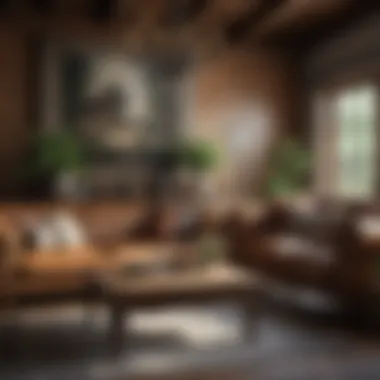
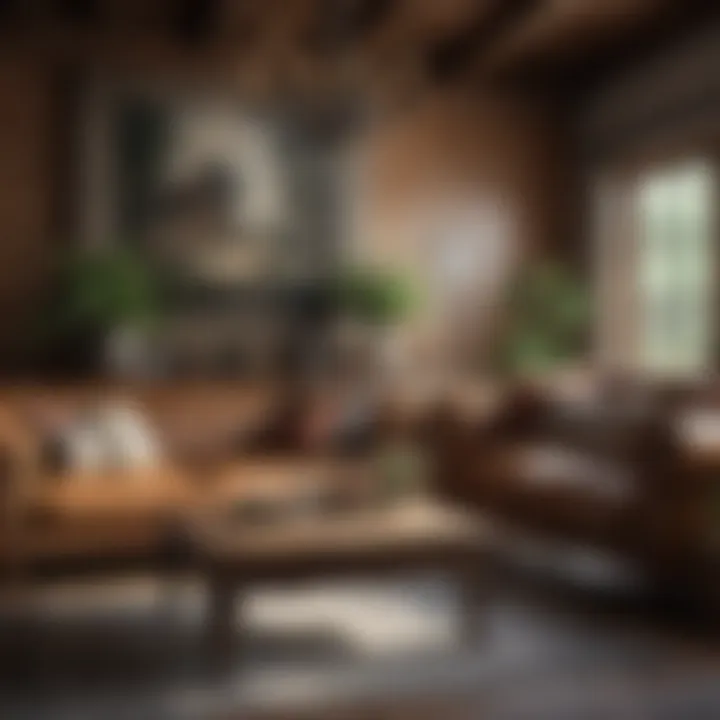
Table lamps are effective for adding layers of light in a rustic living room. They come in various styles and materials, making it easy to find a match for the existing decor. Table lamps are practical and can provide both ambient and task lighting, depending on their placement.
The unique feature of table lamps is their portability; they can be moved or rearranged easily to suit different needs. Their key characteristic is creating cozy nooks within the room. The advantage is the warmth they offer, helping to maintain an inviting atmosphere. However, if there are too many lamps, it may lead to clutter, detracting from the room's serene rustic feel.
Lighting is an essential aspect that ties together the rustic feel of the living room while ensuring functionality. By choosing the right combination of ambient, task, and accent lighting, along with the appropriate fixtures, homeowners can create a balanced and inviting space.
Incorporating Nature into Rustic Interiors
Incorporating nature into rustic interiors enhances the aesthetic while creating a sense of comfort. This practice not only brings elements of the outside world inside, but it also helps to reinforce the rustic principles of using natural materials. Ultimately, nature can offer a harmonious balance and create a living space that fosters both calmness and warmth.
Indoor Plants
Ferns
Ferns are a timeless addition to rustic living rooms. They bring a lush greenery that complements wooden and stone elements widely used in rustic design. Their soft, feathery fronds invite a delicate touch that contrasts beautifully with sturdier furnishings. Ferns are low-maintenance, which is a key characteristic, making them a popular choice. They thrive in humidity and can filter air pollutants, which is a practical benefit. However, they require indirect sunlight and change their appearance in low light, which can be a downside for some.
Succulents
Succulents are another remarkable choice for rustic interiors. They are known for their unique shapes and variety of colors. This diversity allows homeowners to select specific types that will fit their stylistic goals. They are resilient and can thrive on minimal water, making them an ideal plant for busy individuals. Their compact design can effectively fit in small spaces. Yet, these plants also can make a space feel dry if overused, so balance is key when including them in decor.
Herbs
Herbs offer both beauty and practicality, which makes them a great choice for rustic living rooms. They can be used for cooking, enhancing the overall experience of the home. A small herb garden on a kitchen counter or windowsill not only looks appealing but also fills the air with pleasant aromas. One prominent characteristic is their quick growth, allowing homeowners to enjoy them sooner than most plants. Moreover, some herbs may attract pests, which is a factor to consider for those with sensitive environments.
Natural Light Sources
Window Treatments
Window treatments play a significant role in enhancing natural light within a room. They work by controlling how much light enters, thus creating an inviting ambiance. Using lightweight fabrics can promote a breezy atmosphere while allowing sunlight to diffuse gently across the room. Natural fibers like linen or cotton offer a rustic feel. However, heavy or dark window treatments can block light and create a more oppressive environment, which is something to avoid in rustic spaces.
Skylights
Skylights are an exceptional feature in rustic living rooms. They provide a direct source of natural light from above, creating a bright and open atmosphere. By adding a visual link to the sky, they enhance the connection to nature. Skylights can also increase the value of the home by providing this unique aspect. The main consideration is the installation cost, which can be significant, but the benefits they provide often outweigh the expense.
Incorporating elements of nature is essential in achieving the true essence of rustic design. This helps in creating inviting living spaces that feel cohesive and well-balanced.
Common Mistakes in Rustic Living Room Design
Understanding the common mistakes made in rustic living room design is crucial for homeowners and design enthusiasts alike. Avoiding these pitfalls ensures that your space remains inviting and comfortable while embodying the essence of rustic charm. Below are two frequent errors that can diminish the overall aesthetic of a rustic living space, along with considerations for how to steer clear of them.
Overdoing the Rustic Theme
One major mistake in rustic design is the tendency to overdo the theme, transforming the space into a caricature of itself rather than a harmonious environment. This can occur when too many rustic elements are crammed into a single area, creating a cluttered effect that overwhelms rather than soothes. Utilizing an overabundance of items such as worn-out furniture, excessive natural textures, or overly rustic wall art can lead to a space that feels forced and inauthentic.
To strike the right balance, consider the following strategies:
- Select Key Pieces: Focus on a few standout pieces that represent the rustic style rather than filling every corner with rustic items.
- Incorporate Modern Elements: Mixing rustic decor with modern designs can elevate the aesthetic. For instance, pairing a reclaimed wood coffee table with sleek metal accent pieces creates contrast and visual interest.
- Limit Patterns and Textures: While texture is important in rustic spaces, overusing various patterns can create chaos. Stick to a limited palette of complementary materials.
"A well-designed rustic living room should narrate a story of comfort and style, not overwhelm with excessive charm."
Neglecting Comfort
Another common mistake is neglecting the comfort aspect of the living room. While rustic design often emphasizes aesthetics through natural materials and warm colors, it can sometimes sacrifice the comfort of furnishings for style. Choosing a beautiful piece that lacks functionality can lead to dissatisfaction.
To prevent this error, keep these considerations in mind:
- Prioritize Seating Comfort: When selecting sofas and chairs, ensure they are comfortable and inviting. Features like plush cushions and ergonomic designs can complement rustic styles without compromising on comfort.
- Create Cozy Nooks: Arrange seating in a way that fosters conversation and relaxation. Use soft textiles and layered furnishings to make the space feel warm and lived-in.
- Consider the Environment: Ensure that the overall room temperature and lighting are conducive for relaxation. Natural light should be maximized, while artificial lighting should create warmth rather than harshness.
By avoiding these common mistakes, homeowners can create rustic living spaces that are both stylish and functional. This allows the rustic theme to shine through while also providing a welcoming atmosphere for family and guests.
Sustainable Practices in Rustic Design
The notion of sustainability has gained substantial traction in recent years, particularly within the realm of interior design. In rustic design, this is no exception. Incorporating sustainable practices into a rustic living room not only contributes to environmental welfare but also enriches the aesthetic and value of the space. Sustainable practices allow homeowners to utilize materials and methods that are ecologically sound, ultimately creating a home that is not just beautiful, but also responsible.
Choosing sustainable materials and practices fosters a harmonious relationship between nature and home. This is especially relevant for rustic interiors, where the emphasis is often on natural elements. By embracing sustainability, homeowners can make deliberate choices that reflect a respect for the environment. It increases the charm of rustic decor while aligning with a growing concern for climate change and resource depletion.
Recycling and Upcycling
Recycling and upcycling are powerful trends within the sustainable design movement. They involve transforming old objects into something new and functional, minimizing waste and conserving resources. This practice not only saves money but also adds a unique character to the living room.
Some ways to integrate recycling and upcycling include:
- Reclaimed Wood: Using old wood from barns or pallets to create furniture like coffee tables or shelves adds authenticity.
- Second-Hand Finds: Thrift stores often carry furniture and decor items with history. A vintage chair might become a focal point in a rustic living room.
- DIY Projects: Simple modifications, such as painting or refinishing furniture, can breathe new life into old pieces.
"Recycling and upcycling reduce the carbon footprint and celebrate the beauty of imperfection in rustic design."
Through these methods, homeowners can ensure their rustic living rooms are as eco-friendly as they are stylish. Items that tell a story provide depth and warmth, making the space feel more lived-in and inviting.
Sourcing Locally
Sourcing locally is another fundamental aspect of sustainable rustic design. It involves purchasing materials and decor from local suppliers, reducing the carbon footprint associated with transportation. Local sourcing often guarantees higher quality and unique craftsmanship, crucial for achieving an authentic rustic aesthetic.
Consider these benefits of sourcing locally:
- Support for Local Economy: By buying from local artisans and businesses, you help stimulate the economy and foster community relationships.
- Environmental Impact: Reduced transportation means fewer emissions, which is essential in promoting a sustainable lifestyle.
- Unique Styles: Local craftsmen often provide designs that reflect the regional culture, enhancing the uniqueness of your rustic living room.
Integrating locally sourced materials adds authenticity to rustic design while ensuring that each item is sustainable. This showcases not only a love for rustic aesthetics but also a commitment to environmental mindfulness.



